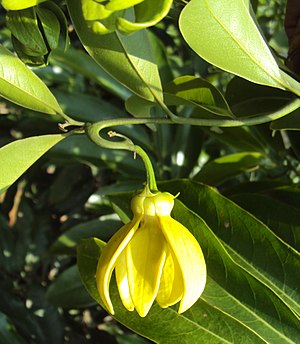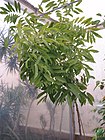Note: This is a project under development. The articles on this wiki are just being initiated and broadly incomplete. You can Help creating new pages.
Artabotrys hexapetalus - Harachampaka
Ylang Ylang is an evergreen climbing shrub, It grows up to 8 metres tall. It is a powerful, far-reaching, many-stemmed woody climber, the old stems of great thickness.
Contents
[hide]- 1 Uses
- 2 Parts Used
- 3 Chemical Composition
- 4 Common names
- 5 Properties
- 6 Habit
- 7 Identification
- 8 List of Ayurvedic medicine in which the herb is used
- 9 Where to get the saplings
- 10 Mode of Propagation
- 11 How to plant/cultivate
- 12 Commonly seen growing in areas
- 13 Photo Gallery
- 14 References
- 15 External Links
Uses
Parts Used
Chemical Composition
3-Hydroxy-9-methoxypterocarpan, nonacosanoic acid 2', 3'-dihydroxypropyl ester, pentacosanoic acid 2,-3'-dihydroxypropyl ester and docosanoic acid have been isolated for the first time from the seeds of Artabotrys odoratissimus and identified by spectroscopic data of these natural products and their derivatives.
Common names
| Language | Common name |
|---|---|
| Kannada | Kandaala sampige, Madana kaamaeshvari, Manoranjana |
| Hindi | Harichampa, Madanmast |
| Malayalam | Madanakameswari, Manoranjitam |
| Tamil | Manoranjitham |
| Telugu | Manoranjithamu, Muddasampenga, Phalasampanga, Manoranjidamu |
| Marathi | Hiravaachaapa, Hirvachampa |
| Gujarathi | NA |
| Punjabi | NA |
| Kashmiri | NA |
| Sanskrit | Harachampaka, Madanah, Nilachampaka |
| English | Fragrant hots Joy |
Properties
Reference: Dravya - Substance, Rasa - Taste, Guna - Qualities, Veerya - Potency, Vipaka - Post-digesion effect, Karma - Pharmacological activity, Prabhava - Therepeutics.
Dravya
Rasa
Guna
Veerya
Vipaka
Karma
Prabhava
Habit
Identification
Leaf
| Kind | Shape | Feature |
|---|---|---|
| Simple | Elliptic-oblong | Leaves alternate, acute at base, shortly acuminate at apex, 6-15 x 2- 4.5 cm, glabrous; lateral nerves 6-18 pairs. |
Flower
| Type | Size | Color and composition | Stamen | More information |
|---|---|---|---|---|
| Bisexual | Solitary | Yellow | Many | Flowers solitary or paired on terminal or leaf opposed hooked peduncles, ca 2 cm across, fragrant; pedicels ca 1 cm long, pubescent. Flowering season is January to March |
Fruit
| Type | Size | Mass | Appearance | Seeds | More information |
|---|---|---|---|---|---|
| Etaerio of follicles | Fruitlets 14-20, ovoid, apiculate, 3-4 cm long, glabrous | Seeds Brown | Fruiting season is January to March |
Other features
List of Ayurvedic medicine in which the herb is used
Where to get the saplings
Mode of Propagation
How to plant/cultivate
Succeeds in a sunny position or in semi-shade. The fleshy fruits are eaten by rats, who thus transport the seeds. The plant has escaped from cultivation in some areas and is reported as being invasive in Hawaii.[4]
Commonly seen growing in areas
Tropical area, Sub Tropical area, Gardens
Photo Gallery
References
- ↑ Jump up to: 1.0 1.1 "Karnataka Medicinal Plants Volume - 2" by Dr.M. R. Gurudeva, Page No.545, Published by Divyachandra Prakashana, #45, Paapannana Tota, 1st Main road, Basaveshwara Nagara, Bengaluru.
- Jump up ↑ Vernacular names
- Jump up ↑ Botanic description
- Jump up ↑ Cultivation details
External Links
- Ayurvedic Herbs known to be helpful to treat Cholera
- Ayurvedic Herbs known to be helpful to treat Scrofula
- Herbs with Flower used in medicine
- Herbs with Leaf used in medicine
- Herbs with common name in Kannada
- Herbs with common name in Hindi
- Herbs with common name in Malayalam
- Herbs with common name in Tamil
- Herbs with common name in Telugu
- Herbs with common name in Marathi
- Herbs with common name in Sanskrit
- Herbs with common name in English
- Habit - Evergreen climber
- Index of Plants which can be propagated by Cuttings
- Index of Plants which can be propagated by Seeds
- Herbs that are commonly seen in the region of Tropical area
- Herbs that are commonly seen in the region of Sub Tropical area
- Herbs that are commonly seen in the region of Gardens
- Herbs
- Annonaceae
- Ayurvedic herbs that don't have seed photos
- Pages without herbs images





